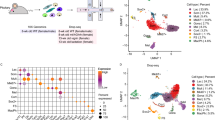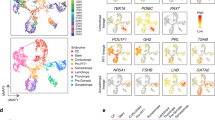Abstract
Over the last two decades we have witnessed the generation of hundreds, if not thousands, of lines of genetically altered mice, large numbers of which are being produced in order to model human disease. Given that their creation is still rather technically demanding and labour intensive, the time taken analysing the resultant phenotypes should be such that the maximal amount of information can be gleaned efficiently in an unbiased manner so as to be as close to the “true” value as possible. In an attempt to characterise a cell-specific phenotype in a genetically defined knock-in mouse model of multiple endocrine neoplasia type 2B (MEN2B) we used a modern, unbiased, stereological approach called the optical fractionator to estimate total cell number in 3-D space. By applying a sampling technique to tissue blocks in a systematic random uniform manner, we demonstrate that the total number of calcitonin-immunoreactive C-cells in the thyroid glands of littermate mice harbouring activating mutations in one or both alleles of ret does not vary significantly (p= 0.46) from an unbiased estimate of 23,000 in wildtype controls; likewise, neither does mean thyroid volume (p= 0.78) when estimated using Cavalieri's principle. We demonstrate that the variation associated with the quantitative phenotyping method is negligible. Using this efficient, unbiased stereological method our results provide new insights into cell number and positioning with consequences for both normal and disease states. In summary, this unbiased stereological technique is conceptually simple, can be applied efficiently, and is pertinent to quantitating a wide variety of cell phenotypes thereby bridging specialisation boundaries. We propose the adoption of this technique to mouse experimental geneticists and recommend its horizontal transmission across all fields within experimental biology.
Similar content being viewed by others
References
Airaksinen MS, Titievsky A and Saarma M (1999) GDNF family neurotrophic factor signaling: four masters, one servant? Mol Cell Neurosci 13: 313–325.
Asai N, Iwashita T, Matsuyama M and Takahashi M (1995) Mechanism of activation of the ret proto-oncogene by multiple endocrine neoplasia 2A mutations. Mol Cell Biol 15: 1613–1619.
Bongarzone I, Vigano E, Alberti L, Borrello MG, Pasini B and Greco A et al. (1998) Full activation of MEN2B mutant RET by an additional MEN2A mutation or by ligand GDNF stimulation. Oncogene 16: 2295–2301.
Borrello MG, Smith DP, Pasini B, Bongarzone I, Greco A and Lorenzo MJ et al. (1995) RET activation by germline MEN2A and MEN2B mutations. Oncogene 11: 2419–2427.
Braendgaard H, Evans SM, Howard C and Gundersen HJ (1990) The total number of neurons in the human neocortex unbiasedly estimated using optical disectors. J Microsc 157: 285–304.
Carlson KM, Dou S, Chi D, Scavarda N, Toshima K and Jackson CE ete al. (1994) Single missense mutation in the tyrosine kinase catalytic domain of the RET protooncogene is associated with multiple endocrine neoplasia type 2B. Proc Natl Acad Sci USA 91: 1579–1583.
Dorph-Petersen KA, Nyengaard JR and Gundersen HJG (2001) Tissue shrinkage and unbiased stereological estimation of particle number and size. J Microsc 204: 232–246.
Feinstein RE, Westergren E, Bucht E, Sjoberg HE and Grimelius L (1996) Estimation of the C-cell numbers in rat thyroid glands using the optical fractionator. J Histochem Cytochem 44: 997–1003.
Festing MF (1976) Phenotypic variability of inbred and outbred mice. Nature 263: 230–232.
Gundersen HJ (1986) Stereology of arbitrary particles. A review of unbiased number and size estimators and the presentation of some new ones, in memory of William R. Thompson. J Microsc 143: 3–45.
Gundersen HJ, Bagger P, Bendtsen TF, Evans SM, Korbo L and Marcussen N et al. (1988) The new stereological tools: disector, fractionator, nucleator and point sampled intercepts and their use in pathological research and diagnosis. APMIS 96: 857–881.
Hanahan D and Weinberg RA (2000) The hallmarks of cancer. Cell 100: 57–70.
Hofstra RM, Landsvater RM, Ceccherini I, Stulp RP, Stelwagen T and Luo Y et al. (1994) A mutation in the RET proto-oncogene associated with multiple endocrine neoplasia type 2B and sporadic medullary thyroid carcinoma. Nature 367: 375–376.
Howard CV and Reed MG (1998) Unbiased Stereology - Three-Dimensional Measurement in Microscopy. Bios Scientific Publishers, Oxford.
McGregor LM, McCune BK, Graff JR, McDowell PR, Romans KE and Yancopoulos GD, (1999) Roles of trk family neurotrophin receptors in medullary thyroid carcinoma development and progression. Proc Natl Acad Sci USA 96: 4540–4545.
Pachnis V, Mankoo B and Costantini F (1993) Expression of the c-ret proto-oncogene during mouse embryogenesis. Development 119: 1005–1017.
Pandit SD, Donis-Keller H, Iwamoto T, Tomich JM and Pike LJ (1996) The multiple endocrine neoplasia type 2B point mutation alters long-term regulation and enhances the transforming capacity of the epidermal growth factor receptor. J Biol Chem 271: 5850–5858.
Ponder BA (1999) The phenotypes associated with ret mutations in the multiple endocrine neoplasia type 2 syndrome. Cancer Res 59: 1736s–1741s.
Reynolds L, Jones K, Winton DJ, Cranston A, Houghton C and Howard L et al. (2001) C-cell and thyroid epithelial tumours and altered follicular development in transgenic mice expressing the long isoform of MEN 2A RET. Oncogene 20: 3986–3994.
Rosenthal A (1999) The GDNF protein family: gene ablation studies reveal what they really do and how. Neuron 22: 201–203.
Russell WMS and Burch RL (1959; reprinted 1992) The Principles of Humane Experimental Technique. Universities Federation for Animal Welfare, Weathampstead.
Santoro M, Carlomagno F, Romano A, Bottaro DP, Dathan NA and Grieco M et al. (1995) Activation of RET as a dominant transforming gene by germline mutations of MEN2A and MEN2B. Science 267: 381–383.
Silver LM (1995) Mouse Genetics - Concepts and Applications. Oxford University Press, Oxford.
Smith DP, Houghton C and Ponder BA (1997) Germline mutation of RET codon 883 in two cases of de novo MEN 2B. Oncogene 15: 1213–1217.
Smith-Hicks CL, Sizer KC, Powers JF, Tischler AS and Costantini F (2000) C-cell hyperplasia, pheochromocytoma and sympathoadrenal malformation in a mouse model of multiple endocrine neoplasia type 2B. EMBO J 19: 612–622.
Songyang Z, Carraway KLI, Eck MJ, Harrison SC, Feldman RA and Mohammadi M et al. (1995) Catalytic specificity of protein-tyrosine kinases is critical for selective signalling. Nature 373: 536–539.
Takahashi M, Asai N, Iwashita T, Murakami H and Ito S (1998) Molecular mechanisms of development of multiple endocrine neoplasia 2 by RET mutations. J Intern Med 243: 509–513.
Takahashi M, Iwashita T, Santoro M, Lyonnet S, Lenoir GM and Billaud M (1999) Co-segregation of MEN2 and Hirschsprung’s disease: the same mutation of RET with both gain and loss-of-function? Hum Mutat 13: 331–336.
West MJ, Slomianka L and Gundersen HJ (1991) Unbiased stereological estimation of the total number of neurons in thesubdivisions of the rat hippocampus using the optical fractionator. Anat Rec 231: 482–497.
Wolfe HJ, Melvin KE, Cervi Skinner SJ, Saadi AA, Juliar JF and Jackson CE et al. (1973) C-cell hyperplasia preceding medullary thyroid carcinoma. New Engl J Med 289: 437–441.
Author information
Authors and Affiliations
Rights and permissions
About this article
Cite this article
Cranston, A., Howard, L. & Vyvyan Howard, C. Quantitative Phenotyping as an Efficient Means to Estimate C-Cell Number in a Knock-in Mouse Model of MEN2B. Transgenic Res 13, 339–348 (2004). https://doi.org/10.1023/B:TRAG.0000040041.61863.20
Issue Date:
DOI: https://doi.org/10.1023/B:TRAG.0000040041.61863.20




